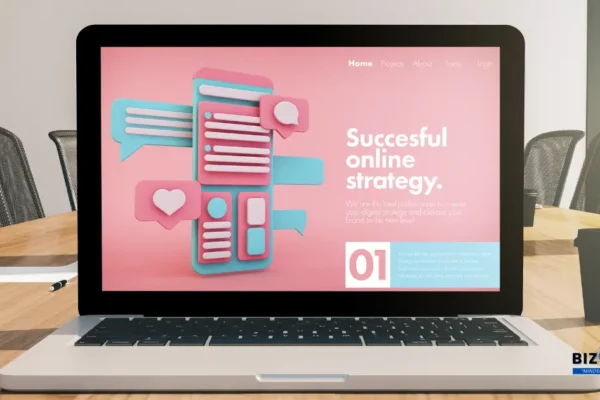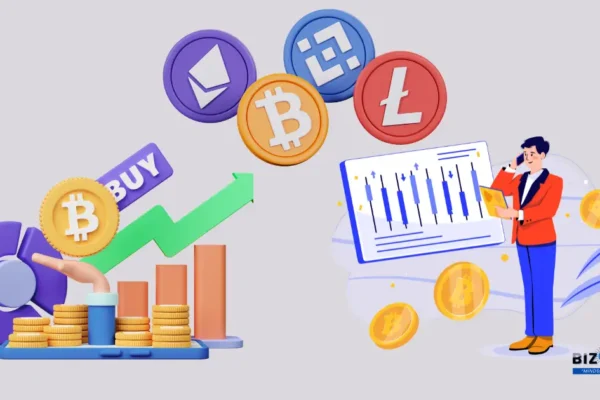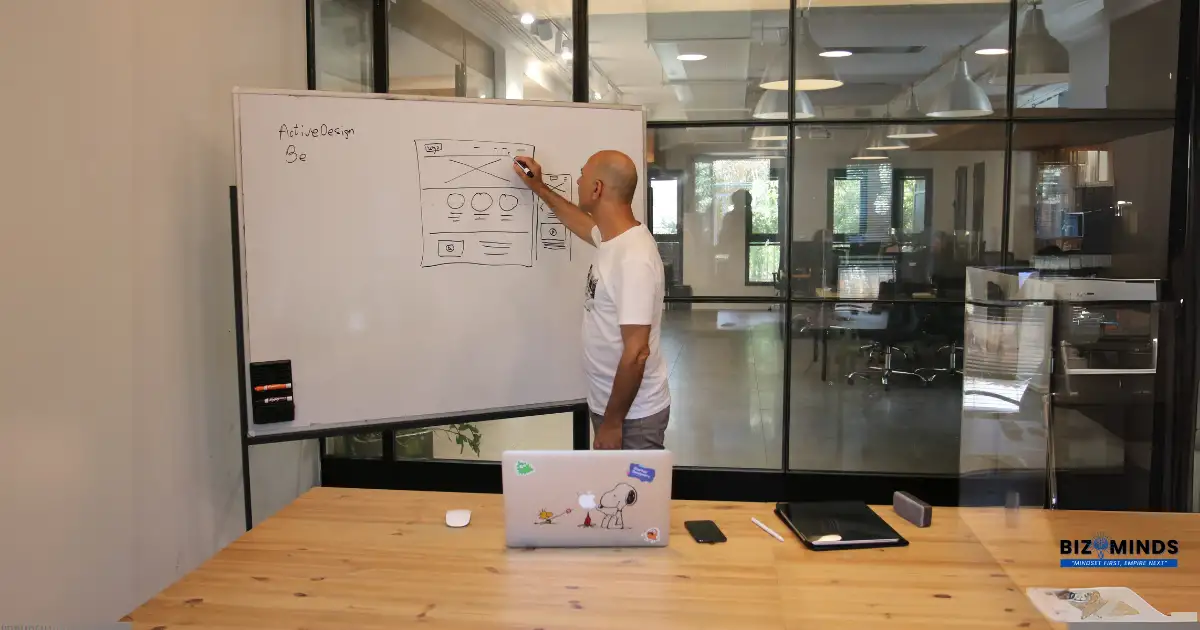
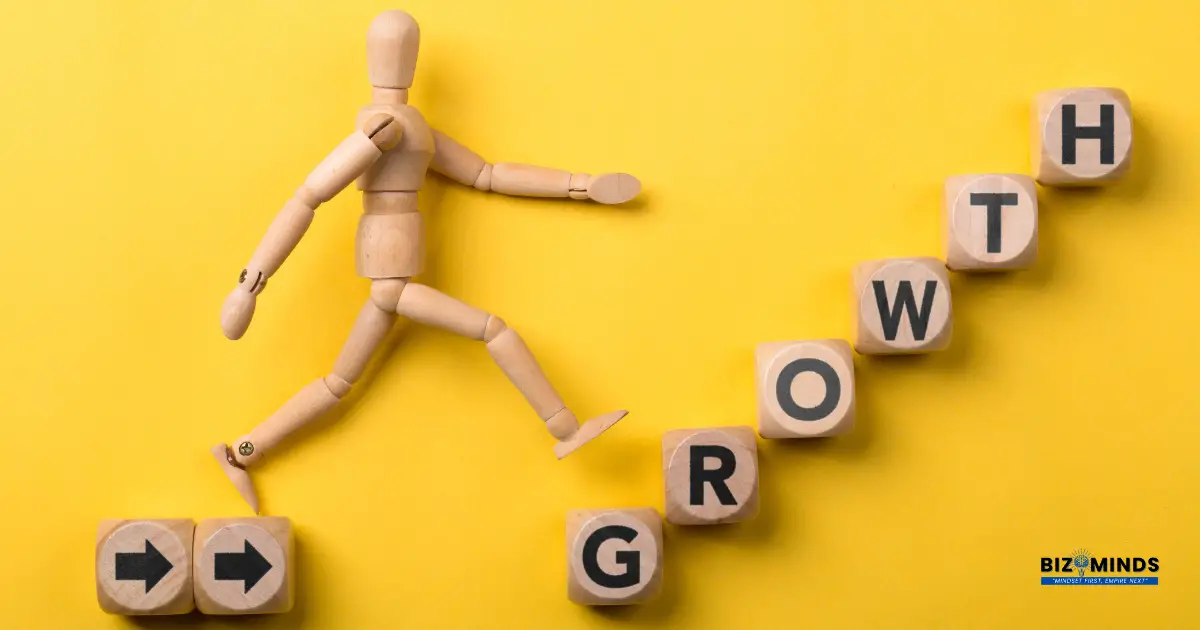
How to Develop a Growth Mindset: Transform Your Success through the Power of Belief
A growth mindset refers to the research-backed conviction that people can enhance their skills, intelligence, and talents by committing to effort, persistence, and drawing lessons from setbacks. Unlike a fixed mindset, which views capabilities as static traits determined at birth, growth mindset recognizes that the brain is remarkably plastic and adaptable throughout life—a phenomenon neuroscientists call neuroplasticity.
Stanford psychologist Carol Dweck, who pioneered this revolutionary research over four decades ago, discovered that this fundamental belief about the nature of ability affects everything from academic performance to career success to personal relationships. Her extensive body of work, which has influenced millions worldwide, demonstrates through rigorous experimental evidence that growth mindset isn’t just a feel-good concept—it’s a scientifically-validated approach to human development with measurable neural correlates.
The research foundation supporting growth mindset is both vast and compelling. Brain imaging studies reveal that individuals with growth mindset show enhanced electrical activity in regions associated with error processing and learning, particularly increased error-related positivity (Pe) amplitudes that correlate with improved post-error performance. Neuroimaging research has identified specific neural networks linked to growth mindset, including heightened connectivity in cortico-striatal pathways between the dorsal striatum and the dorsal anterior cingulate cortex—brain regions crucial for attention regulation and error monitoring.
Perhaps most remarkably, large-scale field studies have validated growth mindset interventions across diverse populations. The National Study of Learning Mindsets, involving 12,490 ninth-grade students across 65 American schools, demonstrated that even brief growth mindset interventions improved grades for lower-achieving students and increased advanced course enrollment. This research has been replicated internationally, with studies spanning from California school districts with over 300,000 students to international assessments involving more than half a million participants across 74 nations.
The implications extend far beyond academic settings. Recent studies show that growth mindset significantly impacts career decision-making, with research indicating that individuals who embrace this mindset demonstrate greater career adaptability, enhanced resilience in professional challenges, and improved recovery from setbacks. The evidence consistently shows that growth mindset creates what researchers call “a powerful passion for learning” that transforms how people approach challenges, view effort, and respond to criticism throughout their lives.
Understanding the Foundation: What Is Growth Mindset?
Research demonstrates that adopting a growth mindset leads to greater motivation, better academic achievement, and a more positive response to adversity, as individuals with this mindset see challenges as valuable experiences for personal development. In contrast, a fixed mindset treats these qualities as unchangeable traits determined at birth, whereas research in neuroplasticity shows the brain remains adaptable throughout life.
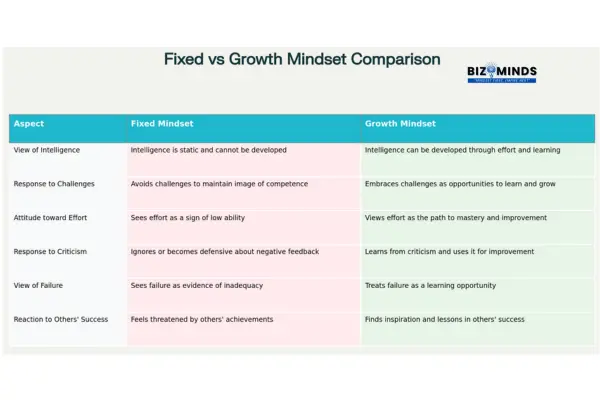
Key Differences Between Fixed and Growth Mindset Approaches
For example, neuroimaging studies have identified enhanced error-related neural responses in individuals who believe skills develop over time. These learners exhibit stronger activity in brain networks responsible for attention and error monitoring, such as connections between the dorsal striatum and anterior cingulate cortex.
Field research further confirms these laboratory findings. In one U.S. study involving 12,490 ninth graders across 65 schools, even a brief intervention shifted students’ academic trajectories—raising grades for those who struggled and increasing enrollment in advanced courses. Similar results emerged in California districts with more than 300,000 participants and in international assessments covering over half a million students.
The impact goes beyond education. Recent work shows that professionals who adopt this outlook navigate career transitions more effectively, recover from setbacks with greater resilience, and display increased adaptability when facing change. In essence, viewing challenges as opportunities creates “a powerful passion for learning,” fundamentally transforming how individuals engage with effort, feedback, and obstacles throughout life.
Key Differences Between Fixed and Growth Mindset Approaches
The Science Behind Growth Mindset
Neuroplasticity: Your Brain’s Remarkable Adaptability
The foundation of growth mindset rests on a crucial scientific discovery: neuroplasticity. Research from leading institutions shows that the brain can literally rewire itself throughout life, forming new neural connections and strengthening existing pathways through experience and practice.
A landmark study published in Psychological Science revealed that people with growth mindsets show increased electrical activity in brain regions associated with error processing and learning. This means that when individuals with growth mindsets make mistakes, their brains are more actively engaged in analyzing and learning from those errors.
The implications are staggering. The creation of new neurons in adult brains—known as adult neurogenesis—mainly takes place in the hippocampus, the region responsible for learning and memory. Studies demonstrate that physical activity, challenging mental tasks, and exposure to enriched environments can enhance this process, literally growing your capacity for learning and adaptation.
Large-Scale Research Validation
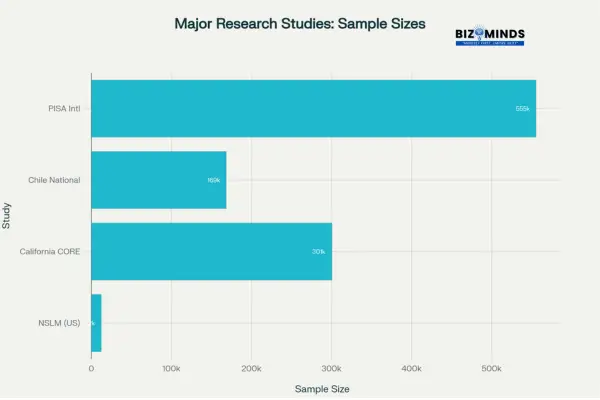
Sample Sizes of Major Growth Mindset Research Studies
The National Study of Learning Mindsets, the largest randomized controlled trial of its kind, involved 12,490 ninth-grade students across 65 schools nationwide. Results showed that a brief, one-hour growth mindset intervention improved grades for lower-achieving students and increased advanced math course enrollment across all achievement levels.
Additional validation comes from:
- California CORE Districts: 300,629 students showed correlation coefficients of 0.27-0.28 between growth mindset and academic achievement
- Chile National Study: 168,533 students demonstrated a 0.34 correlation between mindset and test scores
- PISA International Study: 555,458 students across 74 nations showed significant positive associations in 72 countries
Growth Mindset vs. Fixed Mindset: The Crucial Distinction
Understanding the difference between growth and fixed mindset is essential for transformation. While most people exist somewhere on a continuum between these extremes, recognizing patterns can illuminate opportunities for development.
Fixed Mindset Characteristics:
- Views intelligence and abilities as static traits
- Avoids challenges to preserve self-image
- Sees effort as a sign of inadequacy
- Becomes defensive when receiving criticism
- Feels threatened by others’ success
Growth Mindset Characteristics:
- Believes abilities can be developed through effort
- Embraces challenges as learning opportunities
- Values effort as the path to mastery
- Seeks out constructive feedback
- Finds inspiration in others’ achievements
The American Growth Mindset Success Story: Microsoft’s Transformation
Perhaps no American company better exemplifies the power of organizational growth mindset than Microsoft. When Satya Nadella became CEO in 2014, the company was struggling with internal silos, bureaucracy, and stagnant innovation. Nadella implemented a company-wide cultural transformation centered on growth mindset principles.
The results speak for themselves:
- Stock price increased 5x since the transformation began
- Market capitalization exceeded $1 trillion
- Employee thriving scores reached 77 out of 100 in 2022
- 85% of employees agree diversity is critical to business success
Kathleen Hogan shared that when she started as Microsoft’s Chief People Officer, Satya Nadella made it clear to her that he saw company culture as a key factor in setting Microsoft apart strategically. He believed that how we do things in service to a mission that matters would unlock the potential of our people”.
Microsoft’s transformation demonstrates how growth mindset principles can revitalize entire organizations, moving from what Nadella described as a “know-it-all” culture to a “learn-it-all” culture.
Practical Strategies to Cultivate a Learning-First Outlook
1. Spot and Reframe Fixed-Mindset Triggers
Begin with self-awareness: recognize moments when self-doubt or fear of failure take over. Common triggers include negative feedback, unfamiliar challenges, mistakes, comparisons, and setbacks.
Reframing these thoughts shifts them from obstacles into opportunities:
- Instead of saying, “I’m not good at this,” try thinking, “I’m not good at this yet.” This small change reflects a mindset focused on growth and improvement rather than fixed ability.”
- Replace “This is too hard” with “This will help me grow.”
- Turn “I failed” into “I learned valuable lessons.”
- Change “I can’t do this” to “What strategies can I try?”
2. Leverage the Transformative Power of “Yet”
Adding a single word—“yet”—to a limiting belief can dramatically boost confidence and persistence. Classroom studies in the U.S. show that students who adopt this small linguistic tweak tackle more complex problems and stick with them longer. Examples:
- “I haven’t mastered public speaking yet.”
- “I don’t understand calculus yet.”
- “I’m not a natural leader yet.”
3. Seek Out Constructive Discomfort
Growth happens when you move beyond the limits of your comfort zone. Deliberately choose challenges that stretch your current skill set:
- Professional arenas
– Volunteer for assignments beyond your expertise
– Master emerging technologies or methodologies
– Serve as a first‑time leader of a cross‑functional team
– Earn a certification in an unfamiliar discipline - Personal realms
– Learn conversational Spanish or pick up the guitar
– Prepare for a half-marathon or begin practicing a new yoga regimen
– Enroll in a creative-writing workshop
– Enroll in a debate circle or a public speaking forum
4. Redefine How You Use Feedback
High performers schedule feedback as intentionally as meetings. Turn critiques into fuel for growth by:
- Booking regular one-on-one sessions with mentors or peers
- Requesting precise, actionable insights on specific skills
- Participating in mastermind or peer-review groups
- Implementing 360-degree tools at work
- Building feedback loops into personal projects (e.g., asking for beta-reader reviews of your writing)
5. Practice Smart Persistence
Persistence isn’t merely stubbornness—it’s adaptive resilience. Develop “smarter” perseverance by:
- Setting both performance targets and learning objectives
- Brainstorming multiple ways to solve a problem
- Tracking attempts, setbacks, and incremental gains in a simple journal or app
- Allocating regular “pause and reflect” sessions to adjust tactics
- Celebrating improvements in process—such as mastering a new study technique—rather than fixating solely on end results
By systematically identifying limiting thoughts, embracing minor linguistic shifts, choosing challenges deliberately, soliciting targeted feedback, and persisting intelligently, you’ll build robust mental habits that support continuous development and lifelong learning.
Growth Mindset in U.S. Classrooms: Real-World Transformations
Across the country, American educators have turned classrooms into dynamic workshops of potential, proving that cultivating a belief in learning can reshape even the most daunting educational challenges.
- Harlem Breakthrough
In a high-poverty Harlem kindergarten, students who initially struggled with the basics—some couldn’t even hold a pencil—surged to the 95th percentile on national literacy and numeracy assessments within one school year. By celebrating every small win, reframing mistakes as “practice for success,” and filling the walls with student-generated goal charts, the teacher sparked enthusiasm for effort and normalized struggle as part of learning.
- South Bronx Math Uplift
A fourth-grade classroom in the South Bronx, once languishing near the bottom of state rankings, vaulted into the top decile on New York State Math exams. The secret? Daily “mindset huddles” where students reflected on their problem-solving strategies, shared stories of trial and error, and coached each other through challenging puzzles. Over nine months, average test scores climbed by 28 points, fueled by a collective commitment to view setbacks as roadmaps for improvement.
- Reservation Reading Revival
On a remote Native American reservation in Washington State, a Stanford alumnus returned to lead change at the local elementary school. Faced with dismal reading scores and low engagement, she introduced “growth journals,” where every child chronicled daily learning goals and self-assessed progress. In just 18 months, reading skills climbed from the lowest rank in the district to the upper third, along with a noticeable boost in student confidence and increased community engagement.
These stories illustrate that when educators prioritize perseverance over perfection and spotlight progress over proficiency, even schools grappling with resource limitations can achieve historic gains. Growth-oriented practices—celebrating effort, teaching goal-setting, and fostering peer coaching—turn classrooms into incubators of resilience, curiosity, and academic excellence.
Workplace Applications: Building Learning-First Cultures
In the current competitive environment, American businesses consider prioritizing learning as a key strategic benefit. Employees in such environments are 34 percent more likely to feel deep ownership and commitment to their organization. They embrace calculated risks, drive innovation, collaborate effectively, welcome constructive feedback, and rebound from setbacks with resilience.
To embed this mindset, leaders can:
- Hire for potential, not just past achievements.
- Reward effort and continuous improvement alongside outcomes.
- Cultivate psychological safety so teams experiment without fear of blame.
- Model vulnerability by sharing personal lessons from failures.
- Invest in ongoing development through workshops, online courses, and stretch assignments.
Overcoming Common Barriers
- Imposter Syndrome: Reframe expertise as a lifelong journey. Acknowledge that learning is an ongoing process for everyone, from top executives to entry-level interns, as all individuals continuously acquire new knowledge and skills throughout their roles. Highlight contributions over perfection and celebrate each milestone. Seek mentors and peer communities to reinforce growth.
- Perfectionism: Change the mindset from “It has to be perfect” to “It needs to be meaningful.” Embrace mistakes as essential information that guides the journey toward expertise. Replace the need for omniscience with a commitment to iterative learning, and redirect energy from others’ judgments toward meaningful contribution.
- Avoid making unhealthy comparisons by steering clear of measuring oneself against others in a social-media-driven world, where constant relative evaluation can negatively affect well-being and self-esteem. Focus on personal benchmarks—what progress was made this week versus last. Study high performers to glean strategies, celebrate their success as proof of possibility, and foster collaboration over competition.
Measuring Mindset Shifts
Track both actions and attitudes:
Behavioral metrics:
- How often do you seek stretch assignments?
- How quickly do you recover from missteps?
- How regularly do you solicit feedback?
- Are you comfortable admitting “I don’t know” and asking questions?
Mindset signals:
- Are your inner narratives supportive or critical?
- How do you emotionally respond to failure?
- Do others’ achievements inspire or intimidate you?
- Are you at ease with ambiguity and focused on learning rather than just performance?
Advanced Practices for Long-Term Growth
- Learning Rituals: Set daily intentions for new skills, reflect each evening on lessons learned, plan weekly challenges, review progress monthly, and recalibrate goals quarterly.
- Growth Communities: Join professional networks, participate in skill-sharing meetups, partner with accountability buddies, engage mentors who model learning, and form study circles for complex topics.
- Technology Enablers: Leverage learning-management systems for structured skill development, use apps to track goal progress, adopt feedback platforms for continuous insights, explore virtual reality for safe practice spaces, and experiment with AI-driven coaching for personalized growth pathways.
The Lifetime Payoff
Cultivating this approach is a marathon, not a sprint. Research shows that individuals who consistently apply these principles unlock accelerated career advancement, enhanced innovation capacity, stronger personal and professional relationships, resilient navigation of life’s transitions, and deeper, more sustained life satisfaction. Over time, each incremental shift compounds, turning curiosity into capability and challenges into stepping-stones for ongoing success.
Conclusion: Your Growth Journey Starts Now
Developing a learning-first outlook is not a one-time event but a transformative journey that reshapes how you approach every aspect of life. From the earliest classroom breakthroughs in Harlem to the boardroom renaissance at Microsoft, the evidence is clear: embracing the belief that abilities can grow through effort and reflection unlocks potential that a static view of talent keeps hidden. As you close one chapter of achievement, you open the door to new challenges, knowing that each misstep is not a failure but a stepping-stone toward greater mastery.
In your career, this mindset becomes the engine of innovation. Rather than fearing change or guarding the status quo, you lean into uncertainty, confident that each unfamiliar problem brings fresh insights. When setbacks inevitably arise—missed targets, shifting market demands, or feedback that stings—you don’t retreat. Instead, you analyze what happened, iterate on your approach, and emerge stronger. Over time, this cycle of experimentation and adjustment compounds into breakthrough results, propelling you toward promotions, leadership roles, and industry-shaping ideas.
In education, fostering a growth-centered environment empowers students to transcend limitations they once believed were insurmountable. Teachers who celebrate effort, normalize struggle, and guide learners to reflect on their strategies transform classrooms into laboratories of resilience. The remarkable gains seen in New York, on Native American reservations, and beyond remind us that potential is universal—success hinges on the mindset we choose to cultivate.
Your personal life benefits equally. Whether you’re picking up a new language, recovering from a major life transition, or nurturing relationships, viewing challenges through a lens of possibility enriches each experience. Instead of allowing self-doubt to dictate your choices, you approach new activities with curiosity. You celebrate incremental progress—each conversation in Spanish, each improvised melody on the guitar, each honest dialogue with a friend—knowing that mastery is built one small step at a time.
Sustaining this mindset requires intentional practices: daily reflections, purposeful challenges, and communities that reinforce learning. Technology can support these habits, with apps that track progress, virtual spaces for safe experimentation, and AI coaches that offer tailored feedback. Yet the most potent catalyst remains the belief at your core: that you are not defined by your past performance but by your willingness to grow.
As you move forward, remember that the greatest transformations often arise from the smallest shifts in thinking. Instead of saying “I can’t,” ask yourself, “What can I learn from this?” This shift focuses on growth mindset and learning rather than limitations. You open the floodgates of human potential. By embracing curiosity over certainty, process over perfection, and persistence over resignation, you will continue to evolve—both as an individual and as part of every team, classroom, or community you touch. The path of growth is endless; with each step, you reveal more of what you—and those around you—are truly capable of achieving.
We also have published a deeply researched and informational piece on productivity, please we encourage you to read it too.
Frequently Asked Questions
1. What exactly is growth mindset and how is it different from positive thinking?
This is the research-supported conviction that skills and intelligence can be enhanced through dedication, continuous learning, and perseverance. Unlike positive thinking, which focuses on maintaining optimism, growth mindset is specifically about viewing challenges, failures, and effort as opportunities for development. Research by Carol Dweck shows that it leads to measurable improvements in performance, while positive thinking alone may not produce lasting change.
2. Can adults really develop a growth mindset, or is it easier to learn when you’re young?
Adults absolutely can develop this at any age, thanks to neuroplasticity—the brain’s ability to form new neural pathways throughout life. While children may adopt new mindsets more quickly, adult brains remain remarkably adaptable. Studies show that adult neurogenesis continues primarily in the hippocampus, the brain’s learning center, and can be enhanced through challenging activities and new experiences.
3. How long does it usually take to cultivate a growth mindset?
This development is a gradual process that varies by individual and context. Research from the National Study of Learning Mindsets shows that even a brief one-hour intervention can produce measurable results. However, sustained mindset change typically requires consistent practice over months to years. Most people report noticing shifts in thinking patterns within 4-6 weeks of conscious effort, with deeper changes solidifying over 6-12 months.
4. What are the most common mistakes people make when trying to develop growth mindset?
The most frequent mistakes include: 1) Focusing only on effort without developing better strategies, 2) Using “growth mindset” to justify poor performance without seeking improvement, 3) Expecting immediate results rather than embracing the learning process, 4) Applying this inconsistently across different life areas, and 5) Confusing growth mindset with blind optimism rather than strategic learning from setbacks.
5. How can parents help their children develop growth mindset without creating pressure?
Parents can foster this by: praising the process rather than innate abilities (“You worked hard on that problem” vs. “You’re so smart”), asking questions about learning strategies, sharing their own learning challenges and mistakes, encouraging experimentation without fear of failure, and focusing on improvement over perfection. The key is creating psychological safety where children feel supported in taking on challenges.
6. Can growth mindset help with career advancement and job performance?
Absolutely. Research shows that employees with growth mindset are 34% more likely to feel ownership and commitment to their company, more willing to take on challenges, better at receiving feedback, and more adaptable to change. Companies like Microsoft have demonstrated that growth mindset cultures drive innovation, improve collaboration, and increase employee engagement, all of which contribute to career advancement.
7. Is there scientific evidence that growth mindset actually works?
Yes, extensive research validates this effectiveness. Large-scale studies include the National Study of Learning Mindsets (12,490 students), California CORE Districts (300,629 students), and the PISA International Study (555,458 students across 74 nations). These studies show consistent correlations between growth mindset and improved academic performance, with effect sizes ranging from 0.11 to 0.34. Brain imaging studies also show increased neural activity in learning-related regions among growth mindset individuals.
8. How do you maintain growth mindset during particularly challenging or stressful periods?
During difficult times, maintain this by: breaking large challenges into smaller, manageable learning opportunities; focusing on what you can control and learn rather than circumstances beyond your influence; seeking support and feedback from others; practicing self-compassion while maintaining commitment to growth; and regularly reflecting on past challenges you’ve overcome. Remember that stress and difficulty are often signs that significant learning and growth are occurring.
9. What’s the difference between growth mindset and resilience or grit?
While related, these concepts are distinct. Growth mindset is the belief that abilities can be developed, resilience is the ability to bounce back from setbacks, and grit is long-term persistence toward goals. It can contribute to both resilience and grit by providing a framework for viewing challenges as learning opportunities rather than threats to self-concept. All three qualities can be developed and work synergistically.
10. How can managers and leaders create growth mindset cultures in their organizations?
Leaders can build growth mindset cultures by: modeling vulnerability and learning from their own mistakes; hiring for learning potential alongside current skills; providing regular feedback focused on development; creating psychological safety for experimentation and failure; rewarding improvement and effort alongside results; offering continuous learning opportunities; and encouraging collaboration over internal competition. Microsoft’s transformation under Satya Nadella provides a excellent blueprint for organizational growth mindset implementation.
11. Are there any downsides or limitations to growth mindset?
While generally beneficial, growth mindset isn’t a cure-all. Potential limitations include: unrealistic expectations about what can be changed (some traits have genetic components); using this to justify overwork or ignore well-being; applying it inappropriately in situations requiring immediate expertise; or creating pressure to constantly improve. The key is applying growth mindset wisely while accepting that some limitations exist and that rest and consolidation are part of the learning process.
12. How can growth mindset help with specific challenges like public speaking, technical skills, or leadership development?
This transforms approach to skill development by viewing current limitations as starting points rather than permanent barriers. For public speaking: focus on gradual improvement through practice and feedback rather than seeking perfection. For technical skills: embrace the learning curve and view mistakes as debugging opportunities. For leadership: see leadership as a learnable skill set, seek mentorship, and continuously refine your approach based on feedback and resultsIn every situation, the emphasis changes from asking “Am I good at this?” to figuring out “What steps can I take to improve?”


